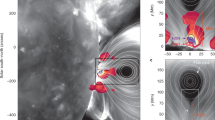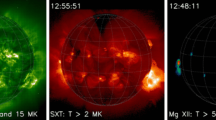Abstract
On 21–22 May, 1980 the HXIS instrument aboard SMM imaged an enormous, more-or-less stationary, X-ray arch structure near the position of a large two-ribbon flare which immediately preceded it in time. As described by Švestka et al. (1982), the arch remained visible for up to 10 hours. Previous inferences of the height, orientation, and physical parameters of this feature have been based largely on the X-ray data and on radio observations of the associated stationary Type I noise storm. In the present paper we use the observed photospheric line-of-sight magnetic field distribution to compute, in the current-free approximation, the three-dimensional topology of the coronal field above the flare site. Comparing the HXIS intensity contours of the arch to the projected shapes of the field lines suggests that the arch is indeed aligned with certain coronal flux tubes and allows an independent determination of the geometrical arch parameters to be made. This procedure indicates that the true height of the arch is about 70000 km, i.e., appreciably less than was suggested previously (although it is still certainly to be classified as a ‘giant” feature of the post-flare evolution).
These results suggest that the arch may be a by-product of magnetic reconnection occurring far above the flare site, analogous to the post-flare loops seen at lower heights. Unlike the latter, however, the field lines undergoing reconnection here link more distant parts of the active region; i.e., they do not represent direct linkages across the magnetic neutral line and thus appear to be topologically quite distinct from those which thread the underlying post-flare loops. In fact, of this group of ‘peripheral” field lines, the arch could simply comprise the lowest-lying ones to have been opened up by the flare process (and the first to reconnect again). This would explain why both the arch and the post-flare loops were visible early in the decay phase, being products of separate reconnection processes. Moreover, because of the lower plasma density and longer cooling times of the arch, this feature persisted long after the post-flare loops faded from view. A calculation of the magnetic energy liberated by reconnection shows that this process is easily capable of satisfying the overall energy requirements of the arch (the latter as determined from observations).
Similar content being viewed by others
References
Altschuler, M. D. and Newkirk, G., Jr.: 1969, Solar Phys. 9, 131.
Altschuler, M. D., Levine, R. H., Stix, M., and Harvey, J.: 1977, Solar Phys. 51, 345.
Antiochos, S. K. and Sturrock, P. A.: 1976, Solar Phys. 49, 359.
Chapman, S. and Bartels, J.: 1940, Geomagnetism, Oxford Univ. Press, London.
De Jager, C. and Švestka, Z.: 1985, Solar Phys. 100, 435.
Harvey, J. W.: 1983, Adv. Space Res. 2, No. 11, 31.
Hick, P. and Švestka, Z.: 1985, Solar Phys. 102, 147.
Kopp, R. A. and Pneuman, G. W.: 1976, Solar Phys. 50, 85.
Kopp, R. A. and Poletto, G.: 1984a, Solar Phys. 93, 351.
Kopp, R. A. and Poletto, G.: 1984b, in G. A. Doschek (ed.), Proc. IAU Coll. 86, 27.
Kopp, R. A. and Poletto, G.: 1986, in R. G. Marsden (ed.), Proc. 19th ESLAB Symp. on the Sun and the Heliosphere in Three Dimensions, p. 65.
Summers, H. P. and McWhirter, R. W. P.: 1979, J. Phys. B12, 2387.
Švestka, Z.: 1984a, Solar Phys. 94, 171.
Švestka, Z.: 1984b, Mem. Soc. Astron. Ital. 55, No. 4, 725.
Švestka, Z. and Poletto, G.: 1985, Solar Phys. 97, 113.
Švestka, Z., Stewart, R. T., Hoyng, P., van Tend, W., Acton, L. W., Gabriel, A. H., Rapley C. G., and 8 co-authors: 1982, Solar Phys. 75, 305.
Author information
Authors and Affiliations
Additional information
On leave from Los Alamos National Laboratory, Los Alamos, NM 87545, U.S.A.
Rights and permissions
About this article
Cite this article
Poletto, G., Kopp, R.A. The magnetic geometry and structure of the giant post-flare arch of 21–22 May, 1980. Sol Phys 116, 163–178 (1988). https://doi.org/10.1007/BF00171721
Received:
Revised:
Issue Date:
DOI: https://doi.org/10.1007/BF00171721




